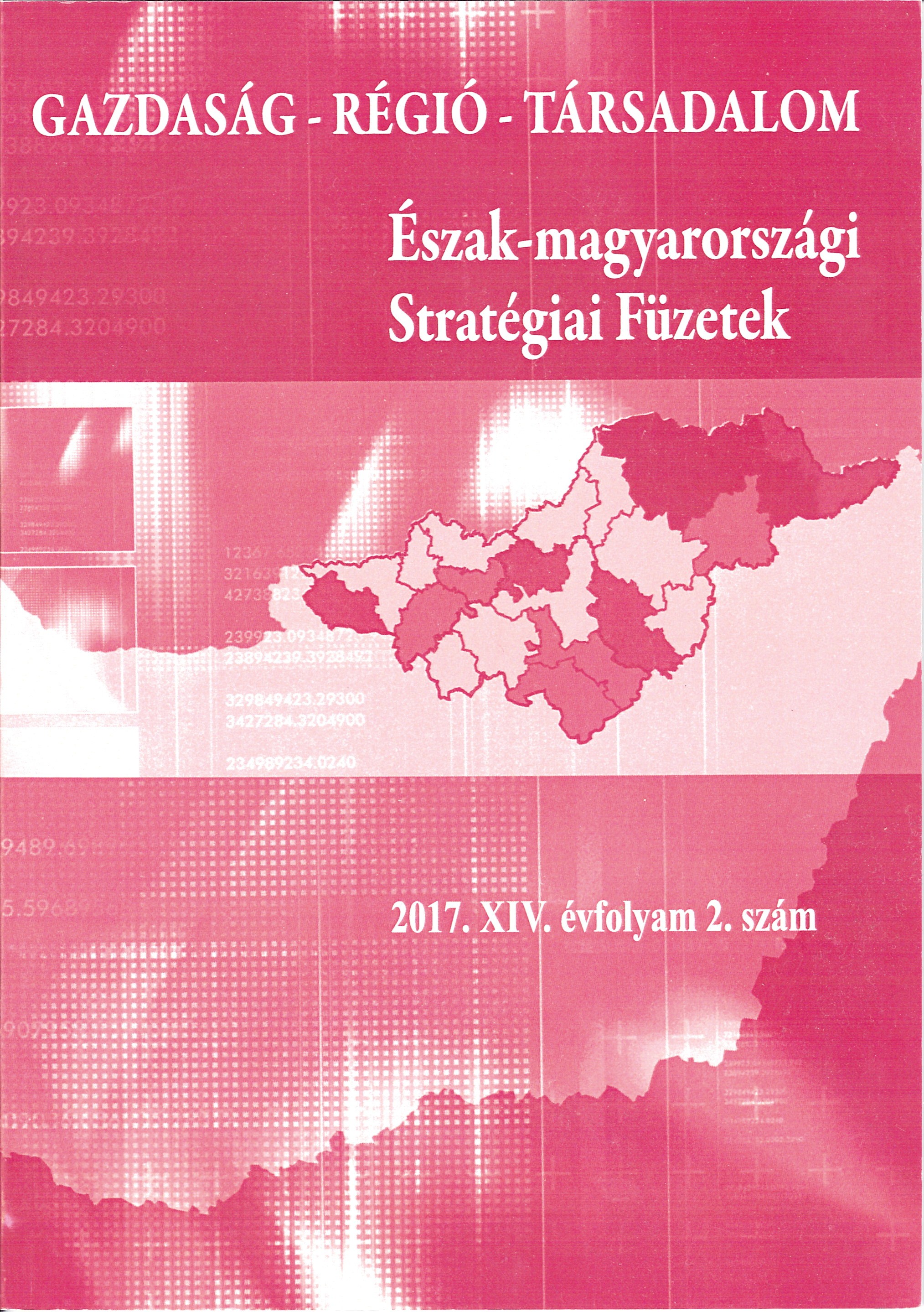Regionális szintű beruházások támogatása: hasznos vagy szükséges rossz?
Kulcsszavak:
állami támogatás, regionális beruházási támogatás, támogatási program, hatásértékelésAbsztrakt
Számos elemzés vizsgálja, hogy az uniós források mennyire fűtik a gazdaságot. Ezek a szubvenciók azonban nem feltétlen azonosak az állami támogatásokkal, azoknak csupán egy része az, ami uniós versenyjogi értelemben vett állami támogatásnak minősül. Így az azoknak tulajdonítani vélt hatás sokkal inkább tekinthető felülreprezentáltnak, mint amilyen valójában. Így abból a feltételezésből indulok ki, hogy az állami támogatásnak minősülő szubvenciók gazdaságra gyakorolt hatásának sokkal inkább kell reálisabb és árnyaltabb képet adnia azokhoz a támogatásokhoz képest, amik az uniós versenyjog szerinti állami támogatásokon kívül esnek. Jelen cikk keretében az uniós szabályrendszer ismertetése mellett empirikus úton kísérletet teszek az egyedi kormánydöntésén alapuló regionális beruházási támogatási program költségcsökkentő és bevétel- ill. foglalkoztatottság-növelő hatásának vizsgálatára 2005-2014 között.
Hivatkozások
ARELLANO, M. (2003): Panel Data Econometrics, Oxford: Oxford University Press.
ARELLANO, M. – BOND, S. (1991): Some tests of specification for panel data: Monte carlo evidence and an application to employment equations. The Review of Economic Studies 58: pp. 277–297.
ARISTEI, D. – STERLACCHINI, A. – VENTURINI, F. (2015): The effects of public supports on business R&D: firm-level evidence across EU countries. Munich Personal RePEc Archive, p. 36. Elérhető: http://mpra.ub.uni-muenchen.de/64611/1/MPRA_paper_ 64611.pdf
BADE, F. J. – BASTIAN, A. (2010): Individual measurement of results of the joint task ’Improvement of Regional Economic Structures. Dortmund/Berlin.
BANAI, Á. – LANG, P. – NAGY, G. – STANCSICS, M. (2017): Impact evaluations of EU subsidies for economic development on the Hungarian SME sector. (Gazdaságfejlesztési célú európai uniós támogatások hatásvizsgálata a magyar kkv-szektorra.) MNB Working Papers 8. p. 54. Elérhető: https://www.mnb.hu/letoltes/eufa-wp-final.pdf
BERLINGER, E. – JUHÁSZ, P. – LOVAS, A. (2015): Az állami támogatás hatása a projektfinanszírozásra erkölcsi kockázat és pozitív externáliák mellett. Közgazdasági Szemle, LXII. évf., 2015. február (pp.139–171.). Elérhető: http://epa.oszk.hu/00000/00017/ 00223/pdf/EPA00017_kozgazdasagi_szemle_2015_02_139-171.pdf
BRONZINI, R. – DE BLASIO, G. (2006): The effect of investment incentives: an assessment of Law 488/1992. Banca d’Italia.
Bizottsági közlemény az Európai Unió működéséről szóló szerződés 107. cikkének (1) bekezdésében említett állami támogatás fogalmáról (HL 2016/C 262/01). Elérhető: http://eur-lex.europa.eu/legal-content/HU/TXT/HTML/?uri=CELEX:52016XC0719(05)&from=EN
BRONZINI, R. – PISELLI, P. (2014): The impact of R&D subsidies on firm innovation. Banca d’Italia. p. 49. Elérhető: http://www.bancaditalia.it/pubblicazioni/temi-discussione/2014/ 2014-0960/en_tema_960.pdf
BUSILLO, F. – MUCCIGROSSO, T. – PELLEGRINI, G. – TAROLA, O. – TERRIBILE, F. (2010): Measuring the Impact of the European Regional Policy on Economic Growth: a Regression Discontinuity Design Approach. Working Papers 6/10, Sapienza University of Rome, DISS. Elérhető: http://www.diss.uniroma1.it/sites/default/files/allegati/wp-06-10-RDD_wp_18%2001%2010_Final_Version2.pdf
CERQUA, A. – PELLEGRINI, G. (2011): Are the subsidies to private capital useful? A Multiple Regression Discontinuity Design Approach. ERSA conference papers, European Regional Science Association. http://www-sre.wu.ac.at/ersa/ersaconfs/ersa11/e110830a Final01323.pdf
CSOMA, R. (2017): Vállalati beruházások, uniós támogatások és a versenyképesség összefüggései. Pénzügyi Szemle 2017/1. pp. 37-47.
COMBES, P. P. – YPERSELE, T. (2012): The role and effectiveness of regional investment aid. The point of view of the academic literature. p. 138. European Commission. ISBN 978-92-79-28198-3
COTTRELL, A. – LUCCHETTI, R. (2016): Gretl’s User Guide. Gnu Regression, Econometrics and Time-series Library.
CRISCUOLO, C. – RALF, M. – OVERMAN, H. – REENEN, J. (2012): The Causal Effects of an Industrial Policy. Centre for Economic Performance, London School of Economics for recent research on the effectiveness of the Regional Selective Assistance (RSA) program in the UK. NBER Working Paper No. 17842. http://www.nber.org/papers/w17842.pdf
HART, M. – DRIFFIELD, N. – ROPER, S. – MOLE, K. (2008): Evaluation of Regional Selective Assistance (RSA) and its successor, Selective Finance for Investment in England (SFIE). Department for Business Enterprise & Regulatory Reform. p. 162. https://www.researchonline.org.uk/sds/search/download.do;jsessionid=B49E953E3DA2D9DE9BC01454E8C0AB43?ref=B9464
KÁLLAY, L. (2014): Állami támogatások és gazdasági teljesítmény. Közgazdasági Szemle, LXI. évf. 3. pp. 279–298.
KOCZISZKY GY. (2008): Területfejlesztés módszertana. Egyetemi Kiadó, Miskolc.
KORNAI, J. (1980): A hiány. p. 642. Kalligram Kiadó. 2011.
KPMG (2017): A magyarországi európai uniós források felhasználásának és hatásainak elemzése a 2007-2013-as programozási időszak vonatkozásában - beavatkozási terület szintű szakmai elemzések. p. 526.
LAKI, M. – VOSZKA, É. (2008): Kaleidoszkóp. Versenyhelyzet Magyarországon 2007-ben. MTA Közgazdaságtudományi Intézet–Pénzügykutató Rt., Budapest.
LAKI, M. – VOSZKA, É. (2010): Kaleidoszkóp. Versenyhelyzet Magyarországon 2008-2009-ben. MTA Közgazdaságtudományi Intézet–Pénzügykutató Rt., Budapest.
LE DEN, X. – KRÖBER, R. – PEZZA, A. R. – GILLERKE, F. – BRESSER, L. – KRÄMER, M. – KHAN, U. – OLIVAS, J. (2012): Ex-post evaluation of regional aid guidelines 2007-2013. Final Report. p. 207. European Commission, DG Competition. 2013.
LELARGE, C. – SRAER, D. – THESMAR, D. (2010): Entrepreneurship and Credit Constraints: Evidence from a French Loan Guarantee Program. NBER Chapters, in: International Differences in Entrepreneurship, pp. 243-273. National Bureau of Economic Research, Inc.
MARTINI, A. – BONDONIO, D. (2012): Support to SMEs and large enterprises in Italy, including a comparison of grants and other financial instruments http://ec.europa.eu/ regional_policy/information/evaluations/impact_evaluation_en.cfm#1
MOUQUÉ, D. (2012): What are counterfactual impact evaluations teaching us about enterprise and innovation support? DG for Regional and Urban Policy, Evaluation and Semester Unit. p. 16. http://ec.europa.eu/regional_policy/sources/docgener/focus/2012_02_counte rfactual.pdf
NAGY, S. GY. – LÓRÁND, B. (2013): Evaluation of EU fund dependency. Dead weight loss and substitution effect. In Pálné Kovács, I. –Scott, J.– Gál, Z.: Territorial Cohesion in Europe. Harthmedia Ltd., Pécs, pp. 109–119.
PIKETTY, T. (2015): A tőke a XXI. században. Kossuth Kiadó, p. 704.
##submission.downloads##
Megjelent
Hogyan kell idézni
Folyóirat szám
Rovat
License

This work is licensed under a Creative Commons Attribution-NonCommercial-NoDerivatives 4.0 International License.



